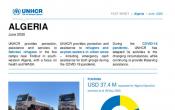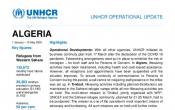Algeria
Operation: Algeria
Location
{"longitude":3,"latitude":27,"zoom_level":5,"iso_codes":"'DZA'"}
By clicking on the icons on the map, additional information is displayed.
The boundaries and names shown and the designations used on this map do not imply official endorsement or acceptance by the United Nations.
Key Figures
| 2019 year-end results | |
| 1,300 | water storage tanks were provided to the most vulnerable families in the camps (Tindouf) |
| 1,000 | 1,000 families (6,400 individuals) received shelter support (Tindouf) |
| 100% | of primary school-aged Sahrawi children had access to education, with 39,400 children enrolled (Tindouf) |
| 100% | of Sahrawi refugees had access to primary health care (Tindouf) |
| 2,500 | asylum-seekers were registered by UNHCR (Algiers) |
| 100 | refugees were supported with multipurpose cash assistance to cover their basic needs, and over 100 were provided with safe accommodation (Algiers) |
| 100 | refugees and asylum-seekers with specific needs received individual psychological support (Algiers) |
| 2020 planning figures |
| 100% | of primary school-aged Sahrawi refugee children will be enrolled in primary education |
| 1,005 | shelter maintenance tool kits and materials will be provided to Sahrawi refugees |
| 250 | refugees and asylum seekers living in urban areas and with psycho-social needs will receive psychosocial support |
| 20 | litres of potable water will be available on average per person, per day |
| 15 | health facilities will be constructed or rehabilitated and equipped with medical supplies |
| 1 | mechanism for the referral of asylum-seekers will be established |
Latest Updates
People of Concern
3%
Decrease in
2019
2019
| 2019 | 100,270 |
| 2018 | 103,276 |
| 2017 | 100,614 |

[["Refugees",98604],["Asylum-seekers",1666]]
Loading ...
Algeria
< Back
2019
{"categories":[2015,2016,2017,2018,2019,2020],"budget":[33.227035854,28.96476598,36.540225983999996,36.36308793,37.09128415,37.43650284],"expenditure":[16.01047015,16.14724515,15.47144188,14.167520119999999,17.01685354,null]}
{"categories":[2015,2016,2017,2018,2019,2020],"p1":[33.227035854,28.96476598,36.540225983999996,36.36308793,37.09128415,37.43650284],"p2":[null,null,null,null,null,null],"p3":[null,null,null,null,null,null],"p4":[null,null,null,null,null,null]}
{"categories":[2015,2016,2017,2018,2019,2020],"p1":[16.01047015,16.14724515,15.47144188,14.167520119999999,17.01685354,null],"p2":[null,null,null,null,null,null],"p3":[null,null,null,null,null,null],"p4":[null,null,null,null,null,null]}
Loading ...
CHOOSE A YEAR
- 2014
- 2015
- 2016
- 2017
- 2018
- 2019
- 2020
Operational context
In 2019, UNHCR continued to provide protection and assistance to refugees and asylum-seekers in Algeria, both in Algiers and in Tindouf.In Algiers, UNHCR conducted registration and refugee status determination, including issuing documentation to people of concern. Advocacy for the adoption of a national asylum framework continued. UNHCR maintained monitoring and advocacy with authorities for the release of refugees and asylum-seekers affected by arrest and return operations. One of the main obstacles was UNHCR’s lack of access to border areas and large parts of the country outside the capital, limiting its ability to reach people of concern.
In Tindouf, UNHCR worked closely with Sahrawi community representatives and civil society across the five refugee camps. UNHCR provided international protection and life-saving assistance to Sahrawi refugees, along with partner organizations. UNHCR coordinated the overall humanitarian response, and was active in the sectors of protection, education, WASH, health, nutrition, food, water, shelter, and livelihoods. A primary challenge included security coverage for humanitarian agencies and partners working in the five camps.
Population trends
The number of refugees and asylum-seekers increased, from some 9,300 in 2018 to 10,400 people of concern registered in Algiers in 2019, most originating from (in order of population size) the Syrian Arab Republic, Mali, Cameroon, Yemen, Guinea and Nigeria. Of the 10,400 people of concern, men made up 45%, women 20%, and the under-18 population 35%. UNHCR continued assistance to the 90,000 most vulnerable Sahrawi refugees near Tindouf, although the number of people in need of humanitarian assistance is estimated to be higher.Over 100 refugees were resettled to third countries during the year.
Achievements
Tindouf- A total of 630,000 m3 of water was distributed to Sahrawi refugees.
- Refugees in Tindouf had greater access to self-employment and business development through enhanced livelihood opportunities, increasing employment particularly for women and youth. A multi-year strategy was developed to improve vocational trainings in the camps.
- Following a nutrition survey of the camp population by UNHCR and WFP, a new nutrition intervention was introduced: over 250 nutrition-vulnerable households received suckler goats (two per family), as well as feed and associated veterinary services.
- UNHCR supported more than 30 multidisciplinary medical commissions from abroad which carried out approximately 8,200 medical consultations and 700 surgical procedures.
- More than 200 refugees were newly recognized, and 2,500 asylum-seekers were registered, all of whom were provided with individual documentation.
- All refugees and asylum-seekers had access to health care, with support and referral by UNHCR’s implementing partner to facilitate access.
- Some 100 survivors of sexual and gender-based violence were referred for assistance, out of which all received appropriate medical orientation and 51% were provided with individual psychological support.
- 68% of refugees identified with resettlement needs were submitted for resettlement - 45% of whom were women and girls-at-risk.
- Over 100 people departed to resettlement countries in 2019 (Canada, Norway, Sweden and the United States of America).
Unmet needs
- Arrests and returns to the borders continued to impact upon people of concern to UNHCR. This remained challenging due to the lack of national asylum legislation to provide comprehensive safeguards for people in need of international protection.
- Although UNHCR engaged with local partners to ensure access to necessary academic and vocational training services, many people of concern were affected by lack of funding and resources. At end of year, the operation was funded to only 47% of its overall needs. As a result, only 35% of schoolbook requirements and 65% of structural improvements to schools required were covered.
- While UNHCR constructed 1,300 water reservoirs for the most vulnerable families in the five camps in Tindouf, the provision of water remained insufficient, particularly for livelihood activities, agriculture and shelter construction. The health and lifesaving sectors remained critically underfunded for camp-based Sahrawi refugees, in particular: 30% of essential drugs were not covered, 20% of laboratory and x-ray needs were not met, and over 50% of medical staff were not remunerated for their work.
Operational Environment
Pending the establishment of a national asylum system in Algeria, UNHCR undertakes a range of protection activities through its offices in Algiers and Tindouf. UNHCR also provides capacity building for relevant partners and authorities. UNHCR collaborates closely with the Ministry of Foreign Affairs and the Algerian Red Crescent.In Algiers, UNHCR conducts registration for asylum-seekers, refugee status determination, advocates for release from detention and provides specialized assistance. The lack of access to border areas and large parts of the country where asylum-seekers are located remains a challenge.
In Tindouf, UNHCR leads inter-agency efforts to support the Sahrawi refugee programme in close coordination with WFP (food assistance) and UNICEF (health, education and child protection). UNHCR leads the Inter-Agency Working Group and Inter-Sector Working Group, the monthly sector coordination meetings for the Protection, Livelihood, WASH and Health sectors, in coordination with the Sahrawi refugee community. UNHCR works closely with the Sahrawi civil society in the five refugee camps, and actively engages in community participation. In Tindouf, UNHCR assists Sahrawi refugees located in five refugee camps, through participatory approaches to encourage engagement and self-management, in particular for the youth. Youth frustration and unemployment will be mitigated in part through livelihoods efforts.
UNHCR’s plan for 2019 is in line with the multi-year, multi-partner protection and solutions strategy for 2018-2021 (MYMP), whose strategic objectives include improvement of the protection space for refugees and asylum-seekers, strengthening camp-based health and education systems, increasing the level of potable water, advocating for a national asylum system, and increasing livelihoods opportunities for youth.
Key priorities
The main priorities of UNHCR will be to advocate for the improvement of the protection space in urban areas and reduce the vulnerability of people of concern to violence and sexual exploitation. UNHCR will continue to cooperate with the authorities on refugee protection in Algeria. UNHCR will make every effort to ensure that refugees and asylum-seekers in urban areas can meet their basic needs and have access to essential services, and to facilitate self-reliance. UNHCR will continue to advocate for the prevention of arbitrary detention or arrest of people of concern. In Algiers, UNHCR will continue to provide support to the authorities in order to finalize a refugee law and relevant implementing regulations on asylum. UNHCR will continue to reiterate the need to grant legal status to refugees and migrants.In Tindouf, UNHCR will strengthen services for people with specific needs, particularly in the areas of health, shelter and education. For meeting shelter needs, UNHCR’s priority is to provide 1,000 family tents to the most vulnerable and construct and equip one pilot centre where young women can learn how to sew the tent fabric. Priorities under education include organizing accelerated French language classes for about 700 Sahrawi students, and supporting students with scholarships in Algerian universities. Under livelihoods, the priorities are to support the establishment of new businesses and collaborative production units through provision of financial and productive assets and training, as well as supporting vocational trainings.
In Tindouf, under-funding constitutes the most pressing constraint in the operation. The situation is further compromised by the harsh climate, and remoteness of refugee camps, which make economic and livelihoods opportunities very challenging. Next year will mark 44 years of displacement for the Sahrawis. UNHCR advocacy and fundraising efforts will continue to address chronic underfunding for the Sahrawi operation.















